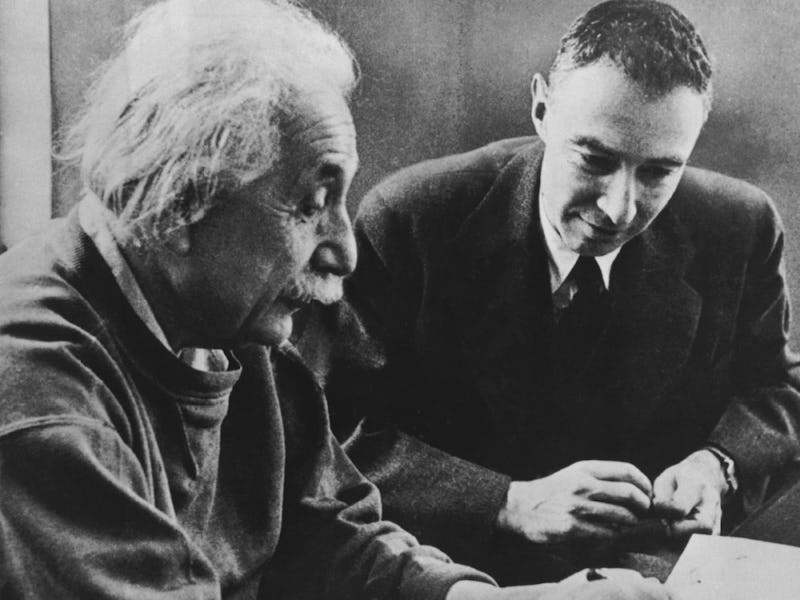Scientists Debunk the Scariest Scene in Oppenheimer
There was never actually a chance of the Trinity Test destroying the world, but it makes for great movie drama.

If you haven’t seen Oppenheimer, spoiler alert: The world’s first atomic bomb explodes about two-thirds of the way through the movie.
And just before it happens, a physicist laughingly takes bets on whether the Trinity Test is about to set the whole atmosphere on fire. Title character J. Robert Oppenheimer ensures an alarmed General Leslie Groves that the chances of that are “near zero.” But where did the idea come from in the first place? With insights from a nuclear physicist and a Pulitzer Prize-winning author, Inverse sheds some light on the myth.
Why Were Manhattan Project Scientists Worried About Blowing Up the Atmosphere?
Here’s a quick primer on how atomic bombs work. When a Uranium-235 atom absorbs an extra neutron, the atom becomes unstable and eventually breaks apart, releasing all the energy that was holding it together — along with two or three stray neutrons. If those neutrons also hit nearby uranium-235 atoms, and if there’s enough uranium in one place under the right conditions, you end up with a chain reaction that releases a truly terrifying, city-destroying amount of energy.
At the same time the Manhattan Project was trying to figure out how to split enough uranium atoms at once to make a bomb, physicist Edward Teller was working on a side project: a hydrogen bomb, which would use a small atomic bomb to kickstart nuclear fusion in a bunch of deuterium (an isotope of hydrogen). That’s the same reaction that powers the Sun but in miniature. It would take another decade for the first hydrogen bomb to become a grim reality, but in 1942, Teller was already thinking about how to build it.
Edward Teller
And that led him to worry, for a little while, about blowing up the whole atmosphere. It was the same principle: a bomb powered by nuclear fission could produce enough heat and pressure to kickstart even more destructive nuclear fusion.
Teller wondered whether the heat and power of the bomb might also be enough to trigger a different kind of chain reaction, in which nitrogen atoms in the atmosphere would fuse together. As Manhattan Project physicist Hans Bethe later recalled, Teller posed the question at a project meeting in 1942. “There's nitrogen in the air, and you can have a nuclear reaction in which two nitrogen nuclei collide and become oxygen plus carbon, and in this process, you set free a lot of energy,” Teller was reported to ask. “Couldn't that happen?”
Bethe did the math — by hand — and came up with an answer.
“There was never any possibility of causing a thermonuclear chain reaction in the atmosphere,” wrote Bethe in the Bulletin of the Atomic Scientists in 1975. “Ignition is not a matter of probabilities; it is simply impossible.”
A photograph on display at The Bradbury Science Museum shows the first atomic bomb test On July 16, 1945, at 5:29:45am, at Trinity Site in New Mexico, U.S.A.
Why Couldn’t the Trinity Test Set the Atmosphere on Fire?
Atoms in Earth’s atmosphere aren’t packed together densely enough for the fusion reaction to work. Nuclear fusion happens in the cores of stars thanks to literally astronomical amounts of pressure, and it’s not possible to make that happen in Earth’s atmosphere. An atomic bomb could compress a small amount of deuterium, in an enclosed space, enough to kickstart fusion, but in Earth’s atmosphere, the whole thing would fizzle out pretty quickly.
“He didn't factor in some of the important things, like how much the fuel had to be not only heated, but compressed,” Richard Rhodes, author of The Making of the Atomic Bomb, tells Inverse.
By the time Oppenheimer and Company were waiting for an overnight storm to clear on the morning of July 16, 1945, everyone knew they weren’t about to destroy the world with a single explosion. Fermi reportedly did take bets on the subject, mostly just to pass the time, but Bethe’s calculations had settled the issue years before. Nuclear doomsday was about to become a real possibility, but it wasn’t going to turn the whole sky into a fireball with a single bomb.
The “near zero” chances Oppenheimer unnerves Groves with in-movie probably come from Manhattan Project physicist Arthur Compton, who told author Pearl S. Buck in a 1959 interview that they’d calculated the odds at “slightly less than one-in-three-million.” In 1975, Bethe denied that there had ever been a less-than-one-in-three-million chance of setting the atmosphere on fire, but the idea had already lodged itself in the public imagination.
“Thus are urban myths born,” says Rhodes.
“Of course, we still have that today, you know: concerns about these big new machines they build,” Notre Dame University nuclear astrophysicist Michael Wiescher tells Inverse, citing a 2008 lawsuit in which two Hawai’i residents tried to stop the Large Hadron Collider from opening because they were afraid it might create an Earth-swallowing singularity — or worse.